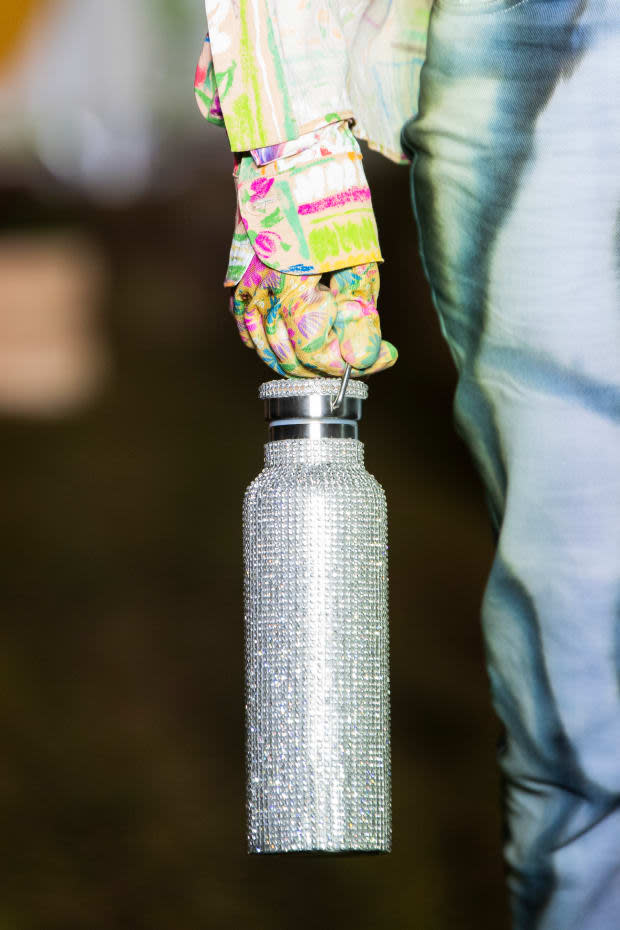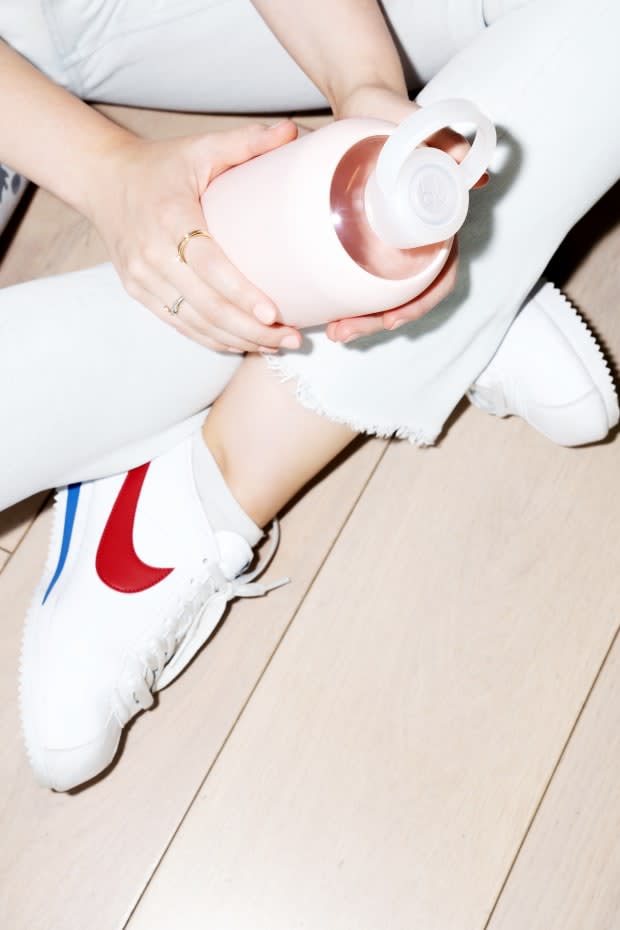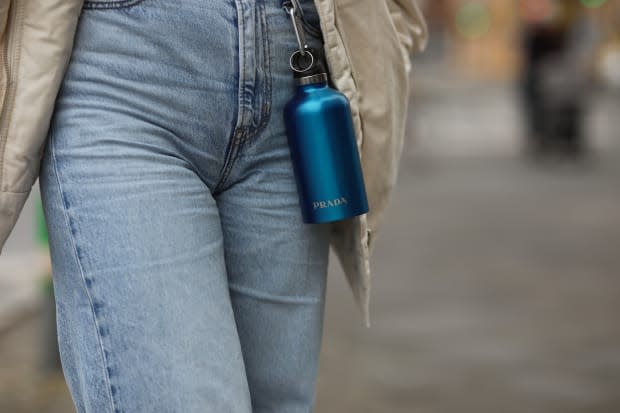The High-Fashion-ification of Reusable Water Bottles
Drink up, you beautiful and capable but dehydrated bitches.
In my high school in suburban Chicagoland in the mid- to late-aughts, Nalgene water bottles were a certain and undeniable form of adolescent social currency. To carry one indicated you were an acceptable amount of granola-y, which, in my crunchy, beachy hometown, was among the most aspirational of characteristics.
We tethered them to our backpacks using carabiners, plastering them with stickers from our favorite establishments in town. If we loved them so much that they started to grow worse for wear, we replaced them with a glossy, brand-new model to then repeat the cycle all over again.
Today, reusable water bottles flood — you know, an early H2O pun — the market with more variations, more brands, more recognizable silhouettes than there were in those Nalgene days. A search for water bottle in 2020 is not unlike that of one for an everyday crossbody bag or pair of ankle-high rain boots, and that's because the water bottle has become an en vogue accessory in its own right. It's shown up with greater frequency on runways and even red carpets in lieu of an evening clutch, à la Maggie Rogers's Chanel carafe at the 2020 Grammys, pictured above.
As of the last two years, the global reusable water market was valued at $8.1 billion, according to data from business consulting firm Grand View Research. By 2025, it's expected to reach $10.6 billion. That's not quite the same explosive growth we've seen across other retail categories like resale or, say, direct-to-consumer natural wine brands. But the water bottle market has been doing something almost more impressive: growing steadily, all before hitting a point of no return.
The fashion industry is not unique in that it is, at least in theory, paying close, direct attention to sustainability and therefore to single-use plastics — and further in this particular instance, to the single-use water bottles that still flood airplane aisles and boutique exercise classes. In recent years, the reusable water bottle has become a sort of microcosm of fashion's environmental interests, particularly as more hydration brands crop up to cater to design-forward consumers, making it easy for consumers to participate in sustainability without it taking a hit to their own aesthetic. And just like any other accessory, water bottles act as a sort of entry-point to the brand or story you want to tell — about yourself, or even just to yourself.

Water bottles are now most often made of plastic, glass or metal, available in all variations of shapes, colors and sizes and at a true variety of price points. The standard 18-ounce Hydro Flask, a necessary appendage to the elusive VSCO girl, retails for around $30, plus a lifetime warranty. But a more luxurious alternative could go for nearly three times that. Glacce, which makes Goop-y glass and stainless steel bottles with removable amethyst crystals inside, currently goes for $84 on Net-a-Porter.
Before couture variations, there were just canteens: purely utilitarian drinking devices to be used by hikers, campers, workers and soldiers in the field. The canteen as we know it only rose to contemporary prominence in the early- to mid-1900s, coming complete with a shoulder strap or other device used to fasten it to one's belt. But canteens date back as early as 60,000 years ago to the Middle Stone Age, with strategically punctured ostrich eggshells having been recovered from Diepkloof Rock Shelter in South Africa.
About 59,960 years later, along came Nalgene. By the 1970s, conservationists began speaking out against the frequent littering of cans and glass bottles. Plastic Nalgenes — made of high-density polyethylene (HDPE) and polycarbonate, and which are now BPA-free — became backpackers' go-to replacement for single-use containers.
RELATED ARTICLES
The Sustainability Conversation Infiltrated the Red Carpet This Awards Season
2019 Was the Year Sustainability Finally Burst Into the Fashion Mainstream
Did Designers Finally Get the Climate Crisis Memo This Fashion Month?
"The way we like to think about it is that we essentially invented the personal hydration category," says Nalgene General Manager Elissa McGee. "We've certainly seen the category evolve over time. We were on the bench at the 1980 Winter Olympics for the 'Miracle on Ice.' We were on TV with 'The Biggest Loser,' when this new balanced health and wellness mindset started to take hold."
By the early 2000s, this led to a newer emergence of personal hydration, with Nalgene bottles beginning to arise on college campuses in front of a whole new, much younger and more versatile demographic than the strictly environmentalists from three decades prior.
In the past 20 years, the market for portable, admittedly cute devices with which to store your life juice has absolutely exploded. McGee estimates this is due in part to the health- and-wellness culture we now know so well. Must we reference the seemingly age-old adage that a supernaturally radiant celebrity "just drinks water" to maintain their structurally perfect face?
But there is also a more critical factor, which is the noted rise in the consumption of single-use plastics. Humans buy about 1 million plastic bottles per minute, according to Earth Day Network, but only 23% are recycled within the U.S. And it's only getting worse: Since the year 2000, we've used more plastic than in all the years before, and by 2030, this is expected to double.

"People are taking stock and saying, 'What can I do from a sustainability standpoint in my life? What are the little ways that I can be more sustainable in what I'm doing?'" says McGee. "This is something that is central to people's lives: What are the things I carry with me?"
Enter, a new generation of water bottles for the aesthetic age, the brands of which offer instantly recognize "It" products that are certainly closer to Alison Lou jelly hoop earrings or Gucci belts than the burlap canteens of yore. Some, like S'well and BKR, are considered to be adjacent to fashion and beauty brands and carried within retailers like Shopbop and Sephora.
Tal Winter and Kate Cutler, who met while in law school, launched BKR (pronounced "beaker") in 2011 when the water bottle they wanted — one that curbed their personal plastic use while also looking good in a $1,400 Louis Vuitton Neverfull — didn't exist. BKR's distinctive design involves a small-mouth top with a wide glass base, and soft silicone sleeves in runway-inspired colors like "Juniper" (a mossy blue-green) and "Bitten" (a rich boysenberry).
"When we started, the people using reusables were a smaller segment of the population and that's really changed," says Winter. "I really feel like every choice you make is an aesthetic choice, and there was aesthetically nothing we found chic and beautiful about the water bottle."
Which brings us up to speed to 2020, where there's no shortage of those chic and beautiful water bottles that Winter and Cutler so desperately wanted to exist a decade ago. At the most extreme end of the spectrum, of course, is Rogers's aforementioned Grammys look, which included a coordinating Chanel bottle.
But even just this past New York Fashion Week season, chic containers have also popped up on runways like Collina Strada — bedazzled with a rhinestoned glass mesh — and in pop-up presentations like Tibi's. In November, Prada released a limited-edition bottle, priced from $75 for a 350 mL size to $85 for 500 mL, that just about decimated Menswear Twitter; secondhand menswear platform Grailed is currently selling versions for upwards of $200.

Rogers's Chanel bottle holster, too, comes at an expectedly steep investment: You can get one on luxury consignment shop Fashionphile for $5,695, roughly the same price of one of the brand's actual, brand-new handbags or instead, roughly six and half pairs of its iconic slingbacks. But you are paying for novelty. Jeannine Scimeme, an adjunct assistant professor for Accessories Design at FIT, considers Fashion Water Bottles™ to be more about social media clout than functional hydration. No one's buying micro-bags for their transport needs.
"Water bottles started with people who wanted to bring their own hydration with them, but they've now trickled all the way up to couture fashion," says Scimeme. "It's definitely an accessory. It's like a handbag, but a little more health conscious, and surely it's way more ostentatious to walk around with a Chanel bottle than with a S'well."
High-end labels like BKR, S'well and the woo-hoo-crystal-infusion ones are operating like they're beauty and accessory companies, all the way down to their hyper-curated vocabulary. Sarah Kauss, S'well's CEO and founder, explains that she launched the bottle in 2010 as a "fashion hydration accessory" to offer consumers a new, more elevated level of style and performance while also limiting waste.
S'well has leaned heavily into design-centric collaborations — with brands like Liberty London, Lilly Pultizer and even Kourtney Kardashian's Poosh — to further extend its brand identity into the fashion space. S'well's partnership with British stationery and leather goods brand Smythson, for example, resulted in a $525 bottle holder in a buttery calf leather. Nalgene, too, has linked up with Pantone, and last February, fancy glass bottle brand Soma created a capsule product with Virgil Abloh and Evian. These limited-edition releases don't just drive hype, but also an association with the fashion industry that pioneered "drop culture" to begin with.
On the planet-saving front, one person's single reusable water bottle — on the runway or red carpet, or my Tuesday evening infrared yoga class — isn't going to make a radical world of difference. But in the oft-cited words of Zero Waste Chef's Anne-Marie Bonneau, we don't need a handful of people doing zero waste perfectly, but millions of people doing it imperfectly. Chanel's quilted lambskin holsters are helping us get there — not to a point of zero waste, but to the intention behind it. It's really not unlike the reasons that environmentalists — or even my classmates and me in 2004 — started carrying the original Nalgene bottles in the first place, no matter the status symbol they may have come to represent.
"It's en vogue to be conscious," says Winter. "Not being aware of what's happening in the world is gross. If you can afford a $5,000 Chanel water bottle, please carry one around because that is rubbing off on people."
Never miss the latest fashion industry news. Sign up for the Fashionista daily newsletter.

